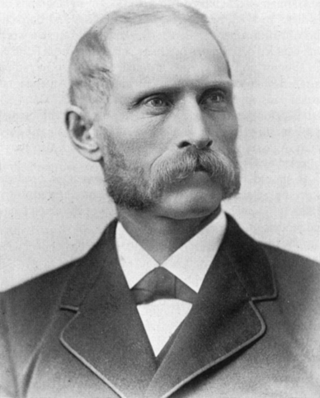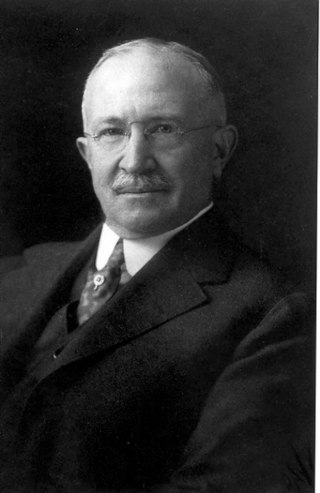Related Research Articles

The footballfish form a family, Himantolophidae, of globose, deep-sea anglerfishes found in tropical and subtropical waters of the Atlantic, Indian, and Pacific Ocean. The family contains 23 species, all of which are classified in a single genus, Himantolophus.

Samuel Walton Garman, or "Garmann" as he sometimes styled himself, was an American naturalist and zoologist. He became noted as an ichthyologist and herpetologist.
Henry Weed Fowler was an American zoologist born in Holmesburg, Pennsylvania.

Edgar Ravenswood Waite was a British/Australian zoologist, ichthyologist, herpetologist, and ornithologist.

Tarleton Hoffman Bean was an American ichthyologist.

Albert William Christian Theodore Herre was an American ichthyologist and lichenologist. Herre was born in 1868 in Toledo, Ohio. He was an alumnus of Stanford University, where he received a Bachelor of Science degree in botany in 1903. Herre also received a master's degree and a Ph.D. from Stanford, both in ichthyology. He died in Santa Cruz, California in 1962.

Charles Henry Gilbert was a pioneer ichthyologist and fishery biologist of particular significance to natural history of the western United States. He collected and studied fishes from Central America north to Alaska and described many new species. Later he became an expert on Pacific salmon and was a noted conservationist of the Pacific Northwest. He is considered by many as the intellectual founder of American fisheries biology. He was one of the 22 "pioneer professors" of Stanford University.

Gigantactis is a genus of marine ray-finned fish belonging to the family Gigantactinidae, the whipnose anglers. The fishes in this genus have a circumglobal distribution in the deep waters of the tropical and temperate zones of the Atlantic, Indian and Pacific Oceans.

Theodore Wells Pietsch III is an American systematist and evolutionary biologist especially known for his studies of anglerfishes. Pietsch has described 72 species and 14 genera of fishes and published numerous scientific papers focusing on the relationships, evolutionary history, and functional morphology of teleosts, particularly deep-sea taxa. For this body of work, Pietsch was awarded the Robert H. Gibbs Jr. Memorial Award in Systematic Ichthyology by the American Society of Ichthyologists and Herpetologists in 2005. Pietsch has spent most of his career at the University of Washington in Seattle as a professor mentoring graduate students, teaching ichthyology to undergraduates, and curating the ichthyology collections of the UW Burke Museum of Natural History and Culture.

Oneirodes is a genus of is a genus of marine ray-finned fish belonging to the family Oneirodidae, the dreamers, a family of deep sea anglerfishes. These predatory, deep-sea fishes are found around the world. This is the type genus, and the most speciose genus, of the family Oneirodidae. They are sexually dimorphic but, like most taxa within their family, the small males are free living and are not sexual parasites on the larger females. Only the females are used to identify the species in this genus as no species specific charaxcters have been found for males.
Coloconger meadi is an eel in the family Colocongridae. It was described by Robert H. Kanazawa in 1957. It is a marine, deep-water dwelling eel from the Gulf of Mexico and Suriname in the western central Atlantic Ocean. It dwells at a depth range of 650–925 m. Males can reach a maximum total length of 37.7 cm.
Gerald Robert "Gerry" Allen is an American-born Australian ichthyologist. His career began in 1963, when he spent a semester at the University of Hawaii, where he also received a PhD in marine zoology in 1971. In 1972, Allen wrote his doctoral thesis on the systematics and biology of the anemone fish.
John Ernest "Jack" Randall was an American ichthyologist and a leading authority on coral reef fishes. Randall described over 800 species and authored 11 books and over 900 scientific papers and popular articles. He spent most of his career working in Hawaii. He died in April 2020 at the age of 95.

Ipnops meadi, also known as the grideye fish, is a highly specialized species of Placodithyran abyssal fish found in the Clarion-Clipperton Zone of the Indo-Pacific Ocean. The species was named after Giles W. Mead of the Harvard Museum of Comparative Zoology, a biology professor at Harvard, deep sea explorer, and ichthyologist.
John Richard Paxton was a United States-born Australian ichthyologist, who spent most of his career at the Australian Museum. He has a particular research interest in lanternfishes and other deep-sea fishes. Paxton is a founding member of the Australian Society for Fish Biology and received the society's K. Radway Allen Award in 1997.
Marie-Louise Bauchot is a French ichthyologist and assistant manager of the National Museum of Natural History, France.

Gigantactis paxtoni, Paxton's whipnose or slender anglerfish, is a species of is a species of marine ray-finned fish belonging to the family Gigantactinidae, the whipnose anglers. This species is found in the deeper waters of the southern Indo-Pacific.
Gigantactis meadi, Mead's whipnose, is a species of marine ray-finned fish belonging to the family Gigantactinidae, the whipnose anglers. This species is found in the deeper waters of the southern Atlantic, Indian and Pacific Oceans.
Erik Bertelsen was a Danish ichthyologist, who specialised in deep sea fish. The fish, Diaphus bertelseniNafpaktitis, 1966 is named in his honour.
Daniel Morris Cohen was an American ichthyologist who was known for his studies on the taxonomy of salmonid, gadid, and ophidiiform fishes.
References
- ↑ "Dr. Giles Mead (1928-2003)". gulfbase. Retrieved 15 August 2024.
- 1 2 3 "Giles Mead, 75; Oversaw Growth of County Natural History Museum". Los Angeles Times. 15 March 2003. Retrieved 15 August 2024.
- 1 2 3 4 5 Daniel M. Cohen; Bruce B. Collette (2004). "Giles W. Mead Jr. 1928-2003". Copeia. 2003 (3): 725–728. JSTOR 1448502.
- ↑ Christopher Scharpf. "The ETYFish Project Fish Name Etymology Database". Christopher Scharpf. Retrieved 16 August 2024.